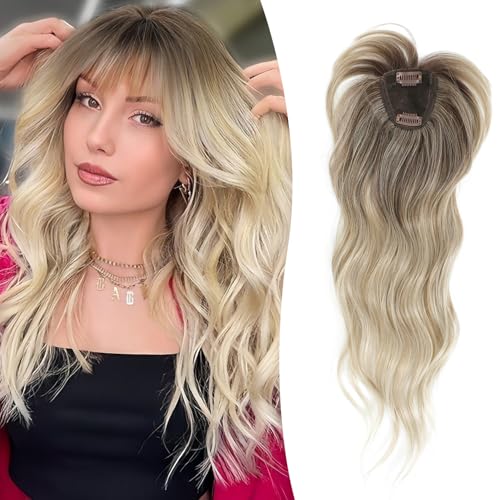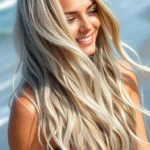Having fine hair doesn’t mean you’re limited to boring or flat styles. We understand the unique challenges that come with thinner strands – from lack of volume to styles that fall flat within hours. The good news? With the right techniques and cuts fine hair can look incredibly full voluminous and stylish.
We’ve discovered that fine hair actually offers some surprising advantages. It’s easier to style holds color beautifully and can achieve sleek sophisticated looks that thicker hair struggles with. The key lies in choosing cuts that work with your hair’s natural texture rather than against it.
Whether you’re dealing with naturally fine hair or experiencing thinning due to age or other factors we’ll share the most flattering hairstyles that create the illusion of thickness and movement. From strategic layering to modern bobs these styles will transform how you think about your fine hair.
Choose the Right Cut Length for Maximum Volume
Length plays a crucial role in maximizing volume for fine hair. We’ll explore how different cut lengths can transform your fine strands from flat to fabulous.
Shoulder-Length Cuts That Add Body
Shoulder-length cuts work exceptionally well for fine hair because they provide the perfect balance between weight and movement. This length prevents hair from becoming too heavy while maintaining enough body to create natural bounce and volume.
Layered shoulder cuts create dimension through strategic texturizing that removes excess weight from the ends. We recommend asking your stylist for long layers that start below the chin to avoid creating thin, wispy sections.
Blunt shoulder bobs offer maximum thickness at the perimeter by maintaining all the hair’s natural density. The straight across cut line creates an illusion of fuller hair while the shoulder length provides natural lift at the roots.
Angled shoulder cuts feature longer pieces in the front that gradually get shorter toward the back. This technique adds movement and prevents fine hair from lying flat against the head while creating visual interest through varying lengths.
Long Bob Styles for Fine Hair
Long bobs hit between the collarbone and shoulder area, making them ideal for fine hair that needs structure without excess weight. These cuts maintain enough length to feel feminine while providing the lift that fine hair craves.
Textured lobs incorporate subtle layers and choppy ends that create natural movement and prevent fine hair from appearing stringy. The key lies in maintaining density while adding just enough texture to enhance natural body.
A-line long bobs feature shorter back sections that gradually lengthen toward the front, creating lift at the crown while maintaining fullness throughout. This geometric shape works particularly well for fine hair because it eliminates weight from areas where hair tends to fall flat.
Wavy long bobs use gentle waves or loose curls to add instant volume and texture to fine strands. The combination of the lob length and wave pattern creates the appearance of significantly thicker hair while remaining easy to maintain.
Short Pixie Cuts That Create Fullness
Pixie cuts eliminate weight completely, allowing fine hair to achieve maximum lift and volume at the roots. These shorter styles work with fine hair’s natural characteristics rather than fighting against them.
Textured pixie cuts feature choppy, piece-y layers that create movement and prevent fine hair from lying flat. The varied lengths throughout the cut add visual depth and make hair appear significantly thicker than its actual density.
Side-swept pixie styles incorporate longer pieces on one side that can be styled forward or swept across the forehead. This asymmetrical approach adds dimension while the shorter overall length maintains volume throughout the cut.
Undercut pixies combine very short sides and back with longer top sections, concentrating fine hair’s volume where it makes the most impact. The contrast between lengths creates dramatic fullness on top while keeping the overall style modern and edgy.
Master Layering Techniques to Boost Texture
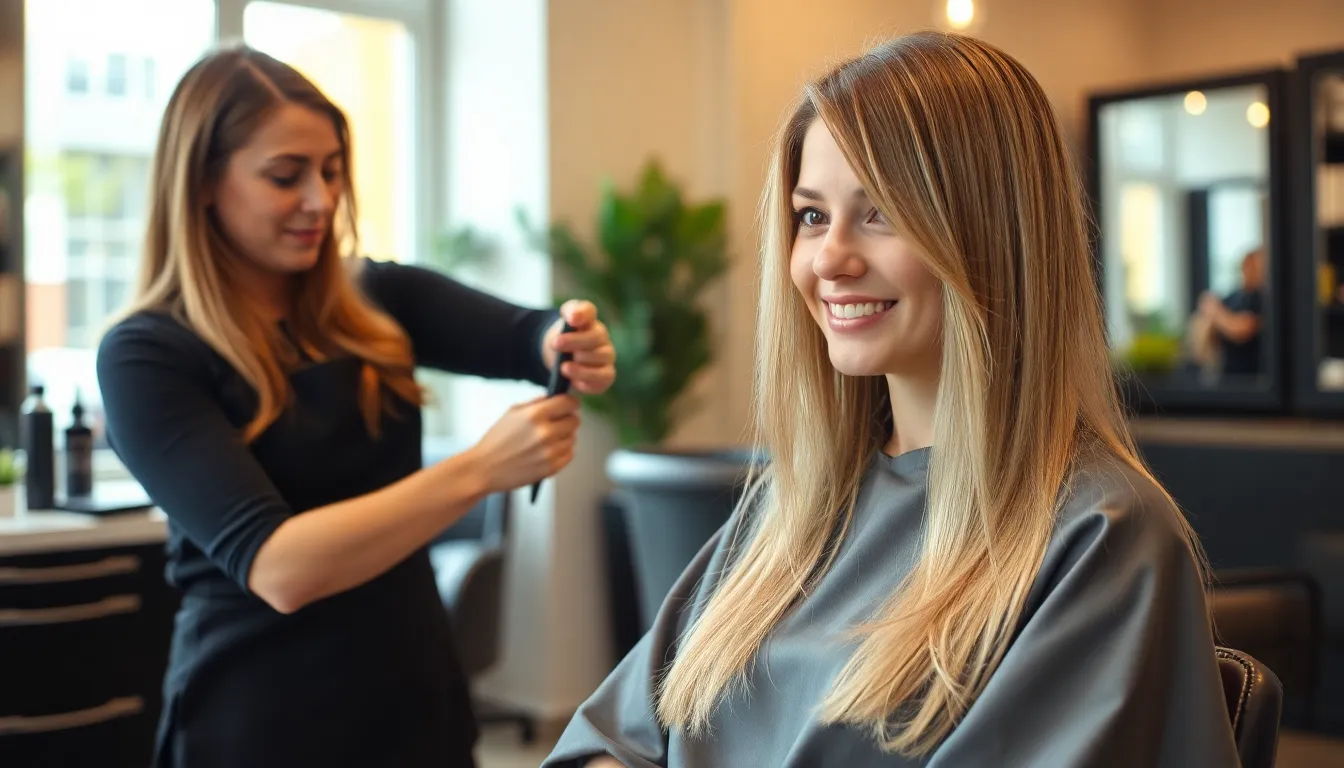
Layering becomes your secret weapon when working with fine hair textures. Strategic cuts create the illusion of density while adding essential movement to otherwise flat strands.
Face-Framing Layers for Movement
Face-framing layers work exceptionally well for fine hair because they create instant dimension around your facial features. We recommend starting these layers at cheekbone level to maintain maximum weight while adding subtle movement. Long face-framing pieces prevent your hair from appearing too thin at the ends.
Stylists typically cut these layers at slight angles to create natural flow rather than blunt edges. The key lies in keeping the layers relatively long to avoid creating gaps in your hair’s overall appearance. Ask your stylist to use point cutting techniques which create softer, more natural-looking edges that blend seamlessly with your base length.
Professional colorists often enhance face-framing layers with strategic highlights or lowlights. These subtle color variations make the layered pieces more prominent and create additional visual texture. The contrast between tones gives fine hair the appearance of increased density and movement.
Choppy Layers for Added Volume
Choppy layers create texture through intentional unevenness that makes fine hair appear fuller and more voluminous. We suggest incorporating choppy elements throughout the mid-lengths and ends rather than near the crown to maintain maximum lift. This technique works particularly well on shoulder-length cuts where the choppy texture can create bouncy movement.
Razor cutting produces the most effective choppy layers for fine hair types. Your stylist can use the razor to create varied lengths that stack upon each other, building visual weight and texture. Point cutting with shears also achieves similar results by creating irregular edge patterns that catch light differently.
Styling choppy layers requires minimal effort since the cut itself provides the texture. Use lightweight texturizing products like sea salt sprays or mousse to enhance the natural movement. Scrunching damp hair while blow-drying activates the choppy texture and creates additional body throughout your style.
Avoiding Over-Layering Mistakes
Over-layering becomes the biggest threat to fine hair because it removes essential weight needed for fullness. We’ve seen countless clients who’ve experienced thinning appearances after receiving too many layers throughout their hair. The golden rule involves maintaining substantial weight in key areas while strategically placing layers for movement.
Avoid asking for layers that start too high up on your head, particularly around the crown area. These short pieces often stick out awkwardly and make fine hair appear even thinner. Instead, request layers that begin below ear level to preserve the bulk needed for volume creation.
Communication with your stylist prevents over-layering disasters before they happen. Bring reference photos showing the exact amount of layering you want and discuss your hair’s exact challenges. Professional stylists understand that fine hair requires a delicate balance between adding texture and maintaining essential weight for fullness.
Embrace Bangs That Complement Fine Hair

Bangs can be a game-changer for fine hair, adding instant volume and creating the illusion of thicker strands. We’ll explore three bang styles that work exceptionally well with delicate hair textures.
Wispy Bangs for Subtle Coverage
Wispy bangs offer the perfect solution for fine hair because they require minimal density to achieve maximum impact. These feathery fringe styles work by distributing fewer strands across your forehead, preventing the heavy, blunt appearance that can overwhelm delicate hair. We recommend asking your stylist to cut these bangs with a razor technique, which creates natural variation in length and prevents harsh lines.
The key to successful wispy bangs lies in their strategic placement just below the brow bone. This positioning allows your natural hair growth patterns to work in your favor while maintaining movement throughout the day. Your stylist should focus on creating texture through point cutting, which removes weight without sacrificing the coverage you need.
Side-Swept Bangs for Face Framing
Side-swept bangs create an elegant diagonal line that draws attention upward while adding perceived volume at your hairline. These versatile bangs work particularly well with fine hair because they use your hair’s natural tendency to lay flat, transforming it into a sleek, polished look. We suggest keeping these bangs slightly longer than traditional straight-across styles to prevent them from appearing too thin.
The styling process becomes effortless with side-swept bangs since they follow your hair’s natural growth direction. You can enhance their shape using a round brush and blow dryer, directing the airflow from roots to ends. This technique creates lift at the root while maintaining the smooth sweep across your forehead.
Curtain Bangs for Modern Appeal
Curtain bangs provide the ideal balance between coverage and openness, making them perfect for fine hair that needs strategic volume placement. These center-parted bangs frame your face on both sides, creating the illusion of fuller hair through their layered construction. We recommend starting these bangs longer than you think you need, as fine hair tends to appear shorter once styled.
The beauty of curtain bangs lies in their versatility with different face shapes and hair lengths. Your stylist should cut them in a soft arc that follows your facial structure, ensuring they blend seamlessly with your overall haircut. These bangs work best when they’re slightly graduated, with the shortest pieces at the center gradually lengthening toward your temples.
Try Volume-Boosting Styling Methods
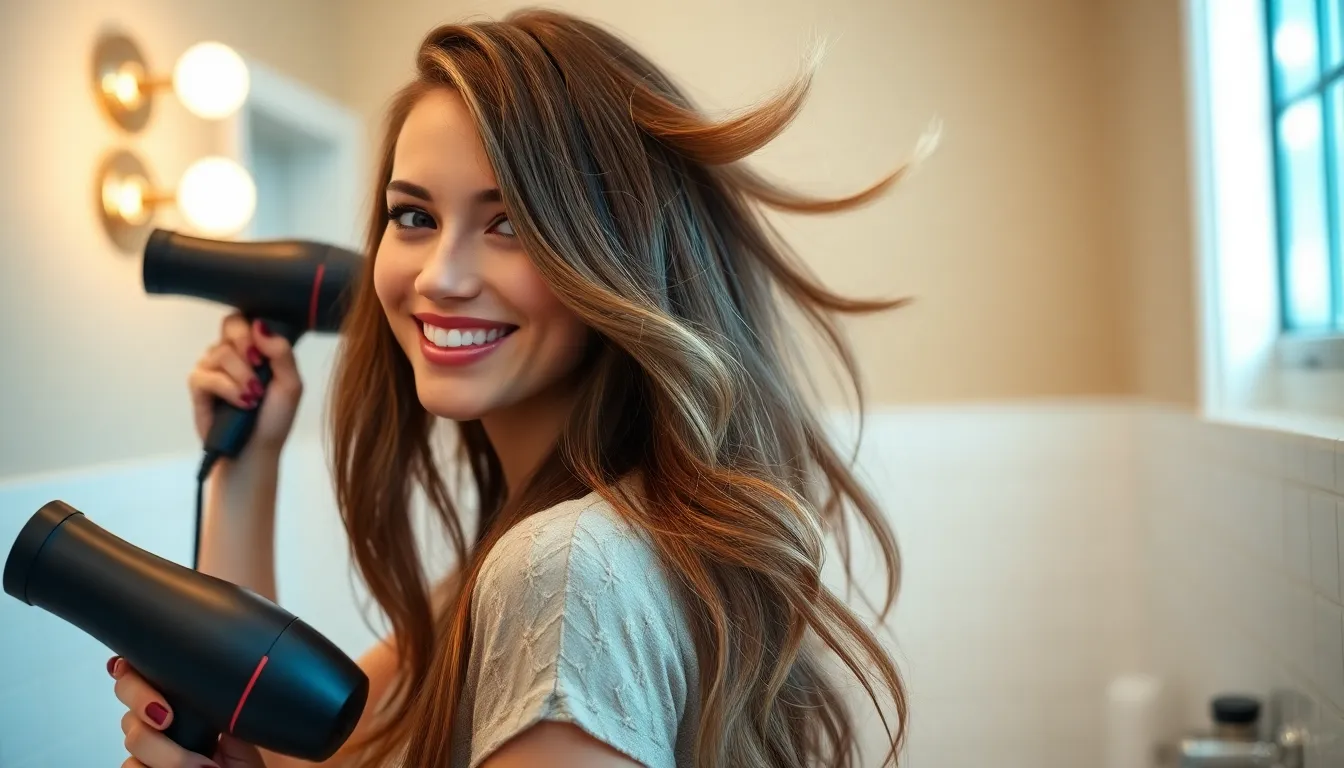
Beyond the right cut and strategic layers, exact styling techniques can dramatically enhance volume for fine hair. These methods work with your hair’s natural texture to create lasting lift and fullness.
Root-Lifting Techniques
Root-lifting sprays create instant volume when applied to damp hair at the scalp. We recommend spraying these products directly onto roots in sections, then lifting hair with your fingers while blow drying. Volumizing mousses work similarly but provide longer-lasting hold throughout the day.
Blow drying upside down remains one of the most effective root-lifting methods for fine hair. Flip your head forward and direct airflow from roots to ends, creating natural lift at the scalp. Using a round brush during this process amplifies results by pulling hair away from the head.
Strategic sectioning maximizes root lift during styling sessions. Clip upper layers away and work on bottom sections first, using a paddle brush to lift roots perpendicular to the scalp. This technique ensures each layer receives proper attention and prevents fine strands from falling flat.
Teasing and Backcombing Tips
Gentle backcombing adds instant volume without damaging fine hair strands. Start by sectioning hair horizontally at the crown, then lightly tease small sections using a fine-tooth comb. Work from mid-length toward roots with short, gentle strokes to avoid breakage.
Texturizing sprays enhance teasing results by providing grip and hold to fine strands. Apply these products before backcombing to create texture that helps maintain volume throughout the day. Sea salt sprays and dry shampoos work exceptionally well for this purpose.
Crown-focused teasing delivers maximum impact with minimal effort for fine hair. Concentrate backcombing efforts on the top section of hair where volume appears most noticeable. Smooth the top layer gently over teased sections to hide any roughness while maintaining lift.
Heat-Free Volume Answers
Overnight braiding creates natural volume and texture without heat damage. Braid damp hair into loose plaits before bed, then gently separate waves in the morning for effortless fullness. French braids starting at the crown produce particularly impressive root lift.
Velcro rollers provide excellent volume for fine hair without requiring heat styling tools. Roll damp sections away from the face and secure for 30-45 minutes, allowing hair to air dry completely. This method creates lasting bounce that fine hair holds beautifully.
Dry shampoo application instantly boosts volume while extending time between washes. Spray product at roots in sections, then massage with fingertips to distribute evenly and lift hair from the scalp. This technique works especially well on second-day hair when natural oils weigh down fine strands.
Experiment with Hair Color for Dimension
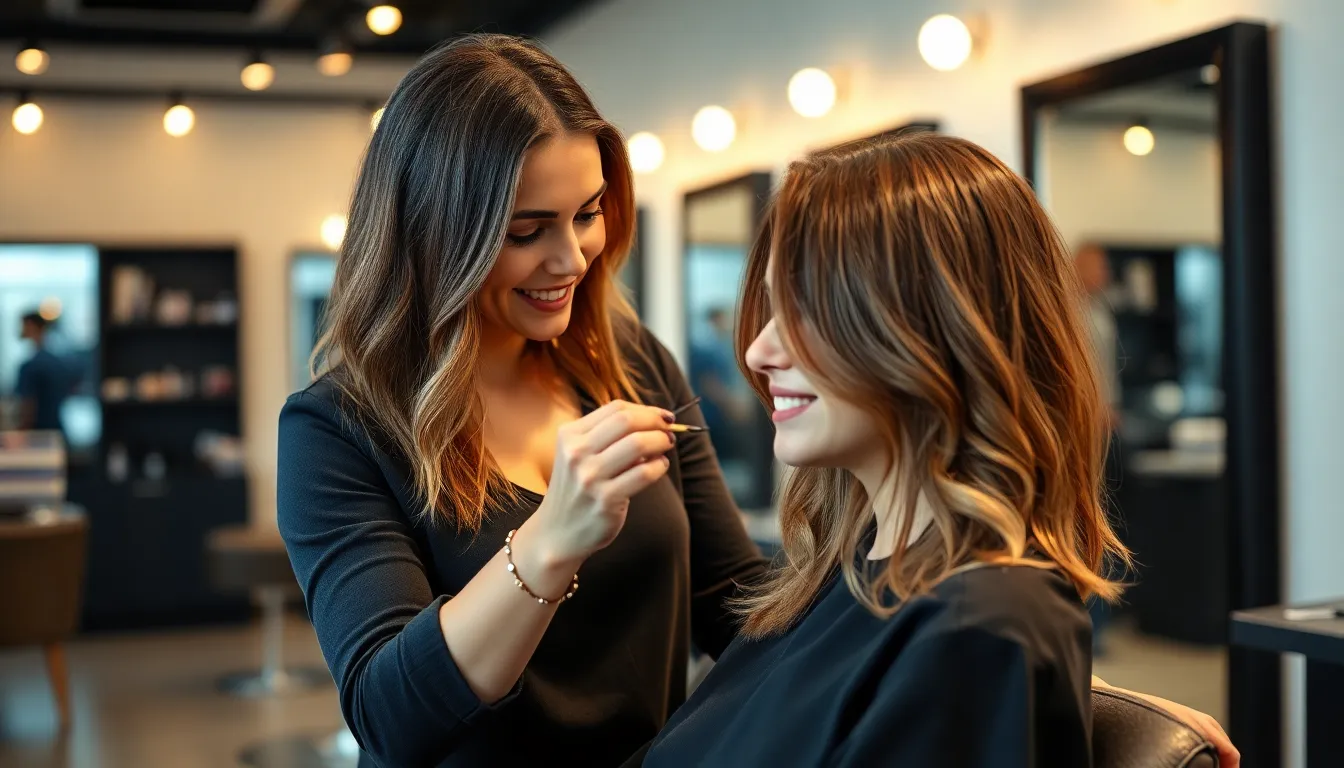
Strategic color placement can transform fine hair by creating visual depth and the illusion of fuller strands. We’ll explore three coloring techniques that work exceptionally well for adding dimension to fine hair textures.
Highlights That Create Depth
Highlights strategically placed throughout fine hair create shadows and light that make strands appear thicker than they actually are. We recommend subtle highlighting techniques that focus on face framing pieces and crown areas where volume is most needed. Babylights work particularly well for fine hair because they create natural dimension without harsh contrast lines.
Foil placement should concentrate on the top layers where highlights catch light most effectively. We suggest keeping highlights within two shades of your natural color to maintain the illusion of density. Chunky highlights can make fine hair appear even thinner by creating obvious gaps between colored sections.
Professional colorists often use cap highlighting techniques for fine hair because they allow for precise strand selection. This method prevents over processing and maintains hair integrity while creating maximum visual impact with minimal color placement.
Lowlights for Natural Thickness
Lowlights add depth beneath your natural color and create the appearance of fuller hair through strategic shadow placement. We find that lowlights work especially well on lighter fine hair because they create contrast that mimics natural hair density variations. Root shadow techniques can also extend time between salon visits while maintaining dimensional color.
Color placement for lowlights should focus on underneath sections and around the hairline where shadows naturally occur. We recommend choosing lowlight shades that are one to two levels darker than your base color for the most natural appearance. Overly dark lowlights can create a striped effect that emphasizes fine hair’s lack of density.
Tonal lowlights using similar hues to your natural color create subtle depth without obvious color lines. This approach works particularly well for brunettes who want to add richness without dramatic color changes that might overwhelm fine hair textures.
Balayage Techniques for Fine Hair
Balayage creates natural looking dimension through hand painted color placement that mimics how sun naturally lightens hair. We prefer balayage for fine hair because it creates soft transitions that don’t emphasize hair density issues like traditional foil highlights might. The painting technique allows colorists to customize placement based on your exact hair growth patterns and density concerns.
Fine hair balayage requires lighter application techniques to prevent over processing and breakage. We recommend starting color application mid shaft rather than at roots to maintain hair strength while creating desired lightening effects. Toner application becomes crucial for achieving seamless blends that enhance rather than detract from fine hair’s natural movement.
Color maintenance for balayage on fine hair typically requires less frequent touch ups than traditional highlighting methods. We suggest using purple shampoos and color protecting treatments to extend color vibrancy between appointments while maintaining hair health and preventing further thinning from chemical damage.
Select Products That Enhance Fine Hair

The right products can transform fine hair from limp and lifeless to voluminous and bouncy. We’ll explore essential product categories that work specifically with fine hair’s unique characteristics.
Volumizing Shampoos and Conditioners
Volumizing shampoos create the foundation for fuller-looking fine hair by gently cleansing without weighing strands down. These specialized formulas contain lightweight polymers and proteins that coat each strand to add thickness while removing excess oils that can make fine hair appear flat.
Sulfate-free options work particularly well for fine hair since they cleanse without stripping natural oils that provide essential body. Look for shampoos with rice protein, biotin, or keratin that strengthen individual strands while creating lift at the roots.
Lightweight conditioners should only be applied from mid-length to ends to avoid weighing down the crown area. Volumizing conditioners contain ingredients like panthenol and wheat protein that add moisture without heaviness. We recommend using these products every other wash to prevent buildup that can flatten fine hair.
Texturizing Sprays and Mousses
Texturizing sprays instantly add grit and grip to fine hair strands, creating the perfect foundation for voluminous styles. These products contain sea salt or clay minerals that roughen the hair cuticle slightly, allowing strands to hold onto each other for increased fullness.
Volumizing mousses provide both lift and hold when applied to damp hair before blow drying. The foam formula distributes evenly through fine strands without creating sticky residue or crunchiness. Apply mousse from roots to mid-length, focusing on the crown and temple areas where volume is most needed.
Heat-activated formulas work synergistically with blow dryers and styling tools to lock in volume throughout the day. These products contain polymers that expand when heated, creating lasting lift that survives humidity and natural hair movement.
Lightweight Oils and Serums
Argan oil provides essential moisture and shine for fine hair without adding weight when used sparingly. Apply just 2-3 drops to damp ends to prevent frizz and add subtle luminosity. This lightweight oil absorbs quickly into fine strands without leaving greasy residue.
Silicone-free serums smooth the hair cuticle while maintaining natural body and movement. These formulas typically contain plant-based oils like jojoba or sweet almond that mimic the hair’s natural sebum production. Focus application on the lower half of hair to avoid flattening the root area.
Multi-tasking elixirs combine the benefits of heat protection, frizz control, and shine enhancement in one lightweight formula. These products work especially well for fine hair because they eliminate the need for multiple heavy styling products that can weigh down delicate strands.
Avoid Common Fine Hair Styling Mistakes

Even with the right cuts, layers, and products, certain styling mistakes can sabotage your fine hair goals. We’ve identified three major pitfalls that prevent fine hair from reaching its full potential.
Heavy Products That Weigh Hair Down
Heavy creams and thick styling products create the fastest path to flat, lifeless fine hair. We see this mistake repeatedly when people apply regular conditioners from root to tip or use heavy leave-in treatments designed for thick hair.
Avoid oil-based serums that contain more than two drops per application. These products coat fine strands and eliminate the natural movement your hair needs for volume. Skip thick mousses with glycerin as the first ingredient since they create buildup.
Choose lightweight alternatives like foam-based volumizers and water-based texturizing sprays. We recommend products with rice protein or hydrolyzed wheat protein that add body without weight. Apply these products to damp hair from mid-length to ends only.
Over-Washing That Strips Natural Oils
Daily washing removes essential oils that fine hair desperately needs for protection and natural volume. We notice that over-washed fine hair becomes more prone to breakage and appears even thinner over time.
Limit shampooing to every other day or try the co-washing method with a gentle cleansing conditioner. Your scalp produces natural oils that act as a volume booster when not constantly stripped away. These oils create the perfect base for styling products to grip onto.
Use dry shampoo strategically on non-wash days to absorb excess oil while maintaining volume. Apply dry shampoo to roots before bed and brush it out in the morning for maximum lift. This technique extends your style while preserving natural oils.
Heat Damage from Excessive Styling
High heat settings above 300°F cause fine hair to lose its natural elasticity and bounce. We’ve observed that damaged fine hair appears flatter because the cuticles can’t reflect light properly, making strands look dull and lifeless.
Reduce heat styling frequency to three times per week maximum. When you do use heat tools, apply a thermal protectant spray and keep temperatures between 250-300°F for fine hair. Lower temperatures still provide effective styling while preserving hair integrity.
Embrace air-drying techniques like scrunching with a microfiber towel or using overnight braiding methods. We recommend the “plopping” technique where you wrap damp hair in a cotton t-shirt for 20 minutes to enhance natural texture without heat damage.
Conclusion
Fine hair doesn’t have to mean flat hair. With the right combination of strategic cuts layering techniques and smart product choices we can transform thin strands into voluminous styles that turn heads.
The key lies in understanding your hair’s unique needs and working with its natural texture rather than against it. From pixie cuts that maximize lift to carefully placed highlights that create depth every technique we’ve explored serves one purpose: helping your fine hair reach its full potential.
Remember that great hair starts with the right foundation. Choose lightweight products avoid common styling mistakes and don’t be afraid to experiment with different approaches until you find what works best for your lifestyle and preferences.
Your fine hair journey is about discovering techniques that make you feel confident and beautiful every single day.
Frequently Asked Questions
What are the main advantages of having fine hair?
Fine hair offers several benefits including ease of styling, quick drying time, and excellent color absorption. It holds color vibrantly and can be restyled easily throughout the day. Fine hair also tends to be more manageable for everyday styling and requires less product to achieve desired looks.
What haircut length works best for fine hair volume?
Shoulder-length cuts are ideal for maximizing volume in fine hair. This length provides enough weight to prevent flyaways while maintaining body. Layered shoulder-length styles, blunt bobs, and angled cuts all work well to create the illusion of thickness and prevent hair from lying flat against the head.
How do layering techniques help fine hair look fuller?
Strategic layering adds texture and movement to fine hair. Face-framing layers starting at cheekbone level create dimension without thinning ends. Choppy layers provide intentional unevenness for volume, while point cutting techniques ensure natural flow. The key is avoiding over-layering, which can make hair appear thinner.
Which bang styles work best for fine hair?
Three bang styles enhance fine hair: wispy bangs offer subtle coverage with minimal density, side-swept bangs create elegance while drawing attention upward, and curtain bangs provide versatile face-framing with strategic volume. Each style adds visual weight and fullness when cut and styled properly.
What are the most effective volume-boosting styling methods?
Root-lifting techniques using specialized sprays and upside-down blow-drying create lasting lift. Gentle teasing and backcombing add volume without damage. Heat-free methods like overnight braiding and Velcro rollers provide natural volume. Dry shampoo on second-day hair effectively boosts volume and extends time between washes.
How can hair color enhance the appearance of fine hair?
Strategic color placement creates visual depth and fullness illusion. Highlights add shadows and light, particularly around the face and crown. Lowlights provide depth and contrast for lighter fine hair. Balayage offers natural-looking dimension through hand-painted color that mimics sun-kissed highlights without weighing hair down.
What products should I use for fine hair?
Choose volumizing shampoos and conditioners that cleanse without weighing hair down. Look for sulfate-free options with rice protein and biotin. Use texturizing sprays and lightweight mousses for grip and lift. Apply lightweight oils and serums for moisture without heaviness. Multi-tasking elixirs combining heat protection work well.
What styling mistakes should I avoid with fine hair?
Avoid heavy products like thick creams and oil-based serums that weigh hair down. Don’t over-wash, as this strips natural oils essential for volume – limit shampooing and use dry shampoo strategically. Avoid excessive heat styling by using lower temperatures and incorporating air-drying techniques to prevent damage.


